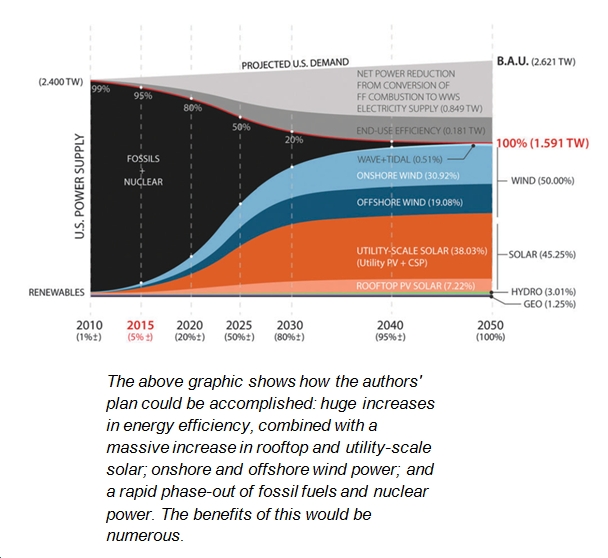Cross posted from Scaling Green
We’ve been making the case consistently for years now that moving from a dirty, unsustainable energy economy to a clean, sustainable one makes sense for a host of economic, environmental and national security reasons. The good news is that the industry is making progress with rapid growth in clean energy penetration that is hailed as a “tipping point” for the technology.
The economics of clean energy have no doubt arrived. As a recent study by Lazard made clear, wind and solar technologies keep getting cheaper and more powerful, a trend that is expected to continue for the foreseeable future. No wonder why the International Energy Agency recently predicted that solar “could be the world’s largest source of electricity by 2050,” and also why the G-7 nations just called for a transformation of electricity generation towards clean sources.
Now, a study by Stanford University engineers details how the U.S. can convert to about 80 percent renewable energy from wind, water and solar by 2030 and 100 percent by 2050. As usual, David Roberts (formerly of Grist, now writing at Vox) explains it very well.
 Key Takeaways:
Key Takeaways:
- 100% renewable energy is possible.
“No one can say any longer, at least not without argument, that moving the US quickly and entirely to renewables is impossible. Here is a way to do it, mapped out in some detail. But it is extremely ambitious.” - Everything must be electrified.
“The core of the plan is to electrify everything, including sectors that currently run partially or entirely on liquid fossil fuels.” Among other advantages, this would result in “an enormous drop in projected demand, since the energy-to-work conversion of electric motors is much more efficient than combustion motors…” - Clean energy pays for itself.
“The potential health and climate gains of a WWS [Wind Water Sunlight] based system are one of the big stories here: they are enormous, enough that in and of themselves they ‘pay for’ a clean-energy transition.” - The plan is ambitious.
To accomplish this, all new power plants built as of 2020 would need to be powered by wind, water or sun. We’d need a great amount of this capacity … “This plan would involve expanding generation capacity fivefold in 35 years,” clearly an ambitious goal. In fact, Roberts writes, the recommended course of action outlined in the Stanford study would “represent an unprecedented level of government activism, a skein of incentives, mandates, standards, and laws unmatched in US history.” - The biggest obstacle is political.
In the authors’ and Roberts’ views, the obstacle isn’t really technical or economic, but political, and it’s a tough obstacle to overcome. This study demonstrates that “this is what we could do if we aimed to create an entirely sustainable, pollution-free energy system.”
The question for the clean energy industry is how to help make this vision a reality.
Mark Sokolove, Executive Vice President of Tigercomm, has been working with cleantech leaders on strategic communications to overcome political and policy hurdles.
“Incumbent energy industries are heavily funded by people like the Koch brothers who inject large amounts of resources into media relations and lobbying,” says Sokolove who has seen huge progress in the industry over his 15+ years as a public relations practitioner.
Sokolove suggests analyzing your business’ or organization’s current external threats and identifying news-making and content generation opportunities. He asserts that this, combined with tight consistent messaging, can help turn the tide against anti-clean energy interests.
“Every on-message headline or piece of visual content brings us one step closer to closing the gap between misinformation funded by the fossil fuel industry and the truth. Since the cleantech industry doesn’t have the history and financial backing that fossil fuels do, the sector needs to work together in building out communications and advocacy infrastructure to help scale clean energy technologies.”












